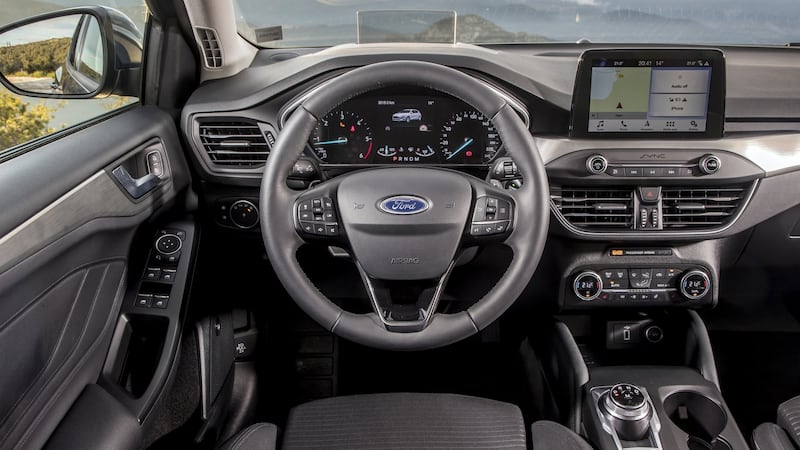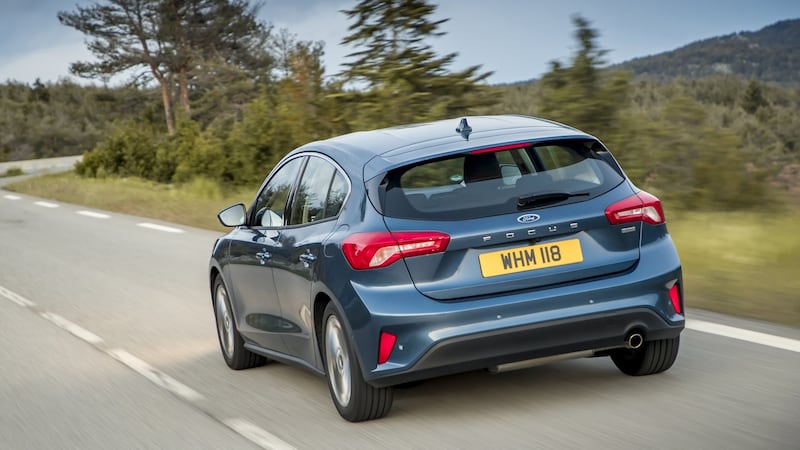There was a time when the arrival of a new Ford Focus was met with great fanfare. It was a firm favourite with Irish buyers, vying with the Volkswagen Golf or Toyota Corolla/Auris for the top spot in the sales tables. Not any more. These days car buyers are crazy about crossovers.
Perhaps that's why Ford makes such bizarre boasts about its new car, claiming it's the "most innovative, dynamic and exciting Ford ever". Even Donald Trump would demure from such hyperbole. Did the PR spinmeister really think we'd regard this 1-litre family hatchback as more "dynamic and exciting" than the Ford GT, the Mustang or even the recent Fiesta ST?
Yet, for all the PR nonsense, the Focus remains an attractive option for family buyers, not least because it now comes in a selection of formats. There’s no saloon this time, unfortunately – that’s reserved for the Asian markets – but there is a very attractive estate, and next year will see the introduction of a so-called Active variant.
This latter version basically involves raising the car by several millimetres and adding hard plastic cladding to the wheel arches. It takes its cue from a look developed by Volvo for derivatives of its family estates. The styling similarities don’t end there: the estate has definite echoes of the previous V50, and even the Focus lettering across the back of the Ford has a Volvo look.
Sadly, the engine options for Irish buyers are limited to just two, along with a shortened list of option packs. Ford Ireland’s managing director, Ciaran McMahon, says this is a result of the new emissions and fuel-economy regime, the first tranche of which comes into effect on September 1st. The so-called WLTP regime – the initials stand for worldwide harmonised light-vehicle test procedure – aims to bring more real-life figures to official emissions and fuel-economy results for each car, but in doing so it will push many new cars into higher motor-tax bands.
The new figures will apply only to cars produced from September 1st onwards, but they mean many car makers are opting to drop certain variants. In the case of the Focus, Ford Ireland has opted to take only two engines to market: a 1-litre 125bhp petrol and a 1.5-litre 120bhp diesel. It's a pity we miss out on the firm's new 1.5-litre petrol, but Irish buyers should not be too upset: the two engines offered are strong performers.

We got to test both on French roads, a mix of motorway and tight and twisting hilly back roads. The petrol is peppy and enthusiastic, but it’s the diesel that is more refined, and its ample torque means it requires fewer gear changes than you might expect. On one motorway stretch we went from cruising along in sixth gear with relatively low revs to overtaking a line of traffic without having to touch the gear stick.
Once more the focus of attention is this hatchback’s handling prowess. Ford has earned a reputation for developing some of the best-handling cars in the mainstream market. It harks back to the early days of the Escort, many of which still grace the starting lines of rally championships for the simple reason that they are incredibly able and fun to drive. The legacy continues through to this car, and the Focus is once more the most engaging hatchback on the market.
That said, it’s not without its foibles. The steering doesn’t feel quite as sharp as we remember from past iterations, and there is also a controversial change (in motoring circles, at least) to the suspension set-up.
Ford has abandoned independent rear suspension on its smaller-engined Focus variants. While high-powered engines and estate variants get the independent rear system for which Ford’s Focus has rightly been praised in the past, the 1-litre petrol and 1.5-litre diesel hatchbacks that will be offered in the Republic come instead with a traditional twist beam (also called a torsion beam) set-up. It’s the first Focus to opt for this format since its introduction, in 1998, as a replacement for the Escort.

Understandably, people’s faces often go blank when you bring up suspension set-ups, but behind the wheel they still notice the difference. We tested the torsion-beam hatchback against the equivalent estate, and you notice the difference.
Although the engineers won't admit it, the move perhaps reflects the changing nature of the market, with buyers more focused on gadgets and practicality than driving performance and engagement
Twist and turn through corners and tackle bad surfaces and in the hatchback all the work seems to be taking place up front, with the rear bouncing along behind as a passive follower. In the longer estate, which should be less agile, the independent suspension makes the rear an active participant in proceedings. It hunkers down when needed and washes out the bumps and undulations of the road as well.
Ford engineers are adamant they’ve created a torsion-beam system on a par with any more sophisticated set-ups offered by rivals. Yet in a comparison to its own independent rear system it trails behind, delivering less control.
Although the engineers won’t admit it, the move perhaps reflects the changing nature of the market, with buyers more focused on gadgets and practicality than driving performance and engagement. In this regard the Focus delivers: Ford has mixed a touch-screen system with a few key button controls, and the result is better than on rivals like the VW Golf. The car also has a wealth of safety features. Although the Focus is squatter than before, the cabin loses none of its space, and even has increased elbow room.
The boot’s a respectable 375 to 1,354 litres in the hatchback, and the seating position both front and rear is comfortable, with good visibility. The Focus is let down, however, by the hard, rather industrial-style plastics in the lower panels of the interior.
The Focus arrives in Ireland this month, with prices starting at €24,900 and four specifications: Zetec, ST-Line, Titanium and the expensive Vignale. Standard features include Ford's Sync connection system with Android Auto and Apple CarPlay, cruise control, LED daytime lights and precollision assist that now recognises cyclists as well as pedestrians and will automatically apply the brakes to prevent a collision. The sportier ST-Line adds a sports suspension set-up that's 10mm lower than the regular variants.
Overall the Focus remains the most fun-to-drive regular hatchback on the market, although that crown doesn't sit as easily as it did before
Overall the Focus remains the most fun-to-drive regular hatchback on the market, although that crown doesn't sit as easily as it did before. As for its fit and finish, while it closes in on the lead held by the VW Golf, the German is still out in front. Rivals like the Kia Ceed have closed the gap on Ford's driving dynamics, but for now, when you are behind the wheel of a regular small-engined hatchback, the Focus delivers the most fun.
Ford Focus: the lowdown
Engines 1-litre 125bhp petrol or 1.5-litre 120bhp diesel
Prices From €24,900
Arriving July 2018 (Active versions will come next year)











